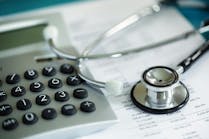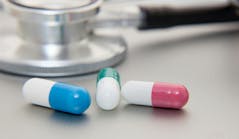Drones may fulfill future, next-generation delivery, freight, shipping services on smaller scale
Unmanned aerial vehicles (UAVs), otherwise known simply as “drones,” increasingly are being used inside and outside of healthcare for a variety of logistical functions. Inside of the healthcare industry, drones are used by suppliers and providers alike to deliver drugs, medical supplies and other products to remote areas, as well as within a local campus setting or across town.
Ideally, healthcare providers embarking on “hospital-at-home” programs and even home health providers are exploring whether drones can be used for same-day or next-day product deliveries, not unlike what Amazon and others accomplish in the consumer world.
Healthcare providers and suppliers also can rely on drones for more than just making deliveries. They also can use them to track and trace inventory within a warehouse or consolidated service centers – particularly those with high racking and shelving and narrow aisles – and they can be used to monitor and redesign workflow pathways and conduct security surveillance externally and internally.
As healthcare interest in drone use blossoms with providers exploring legitimate cost-effective and efficient applications to justify investment, Healthcare Purchasing News tapped executives at nearly a dozen different distribution, logistics, and supply chain companies for their insights on where to start and how to cost-justify their use beyond “playing with cool and expensive toys.” Here’s what they shared.
On which function(s) serve(s) as a sensible starting point for healthcare organizations to invest in drone technology.
Tom Redding, senior managing director, Healthcare Services, St. Onge Co.
“Depending on the geographic location of a healthcare organization, the most logical use of drones is to support the delivery of pharmaceuticals and/or supplies to its patients. Drones can effectively supplement an organization’s robust courier program to ensure timely delivery is achieved across their patient population. Additionally, drones could quickly be deployed in a healthcare provider’s distribution center/warehouse to effectively monitor, assess, and identify inventory issues, including cycle count through the use of RFID and vision technology.
“Drones also will provide organizations with the ability to quickly scale and adapt to service delivery requirements. The ‘care at home’ model will drive healthcare providers to rethink how they can proactively support their patients in a real-time manner. As organizations explore how they can provide same-day and/or hourly deliveries, their current courier model may not be able to meet service expectations.”
Mark Speight, COO and partner, Caduceus Medical Logistics
“Drones offer a lot of opportunities to extend visibility, replace challenging or difficult tasks, and also to provide various benefits as a new mode of transportation. Bringing drones into a healthcare system can be as simple or complex as you choose to make it. There are a lot of drone vehicles, an evolving regulatory market, and a vast amount of software and service providers. Bringing drones into an inventory management process or for use with security and surveillance with a parking lot or facility, requires some research for the right match to drone platform, but once decided, these two use cases offer a simple procurement process for acquiring assets and insurance. The drone provider typically can provide training and help with onboarding and then you’re up and running pretty quickly.
“For product deliveries, there is a lot more to consider, especially around regulations and required certifications. Starting small, with one or two locations utilizing drones for a short period of time (e.g., one to six months), seems to propose a good recipe for success. We, as a ground courier service, are starting to test drones as a new mode of transportation, and drone industry experts continue to recommend a crawl-walk-run approach. There’s a lot that can be learned from testing a short (one-to-three-mile) delivery route between medical facilities. This approach would also be good for testing inventory management, or with deploying security and surveillance drones. Staring with one location presents an environment for learning, but with controlled risk.
“Introducing new devices can have a great effect on internal and external processes and there’s a lot of education and questions around drones, especially with cameras, privacy, and noise. Creating an internal communication strategy and working with your local community are also other critical first steps if considering the use of drones for product transport. Having internal documents to share FAQs, goals, and timelines will help with organization acceptance, and then speaking with the community can help to drive economic development, gain equity, and help plan for supporting infrastructure.”
Mike DeSimpelaere, vice president, Network Operations, Cardinal Health at-Home Solutions
“While we are not currently using drones in our at-Home Solutions facilities, using drones and visual inventory capture would be a strategy to do cycle counts/inventory management-type functions, especially for those that are doing self-distribution/warehousing. One consideration is that there are FAA regulation hurdles to overcome to have any type of scale for drone deliveries across any type of distance. Much of the country is not approved for this type of activity via the FAA currently.”
Norman Brouillette, senior vice president, Supply Chain Solutions, Retail, Tech & Health, Ryder System
“While drones can be useful in many ways, there are some situations in which drones are more successful. For example, if you think about a warehouse operation where a drone may be useful in auditing or cycle counting, all inventory would need to have consistent, outward-facing labels that are visually accessible to the drone’s camera. Not all warehouse operations are set up that way. Think about a multi-pallet-deep storage, or storage types that do not have labels visible from a flight path, the drone would likely not be successful.
“Also, often times, automating a warehouse will minimize a drone’s effectiveness. For example, we implemented an automated storage and retrieval system (ASRS) for a healthcare network. That ASRS maintains near-perfect storage accuracy, while eliminating the need to scan due to its efficient cubed-storage system. So, in that case, a drone would not add value.
“Then, when you think about outside applications, drones may face challenging weather conditions specific to regional areas and other restrictions and regulations, such as when a drone’s flight path would require FAA approval.”
Derrek Seif, Chief Strategy and Product Officer, VPL
“Drones can significantly improve the speed and efficiency of delivering essential medications to rural areas that are difficult and expensive to serve with traditional logistics services. Their ability to navigate quickly and directly, avoiding congested areas and reducing delivery times, helps patients in several ways.
“In rural areas where limited access to healthcare providers can make it difficult for patients to obtain the medications they need, drone delivery provides a solution that improves access to medications. This not only addresses the challenge of limited access but also reduces the overall cost of medications, which can be a barrier for rural patients. By eliminating the need for patients to travel long distances to get their prescriptions filled, drone delivery helps to lower medication costs. By providing efficient and timely access to medications, drone delivery has the potential to improve patient outcomes in rural areas where limited access to healthcare providers can pose challenges.
“In addition to benefiting patients, drones also alleviate the burden on rural healthcare providers who often face heavy workloads and staff shortages. By enabling efficient medication delivery without requiring a staff member to personally handle each delivery, drones offer much-needed relief to overworked healthcare professionals.
“Drone delivery of medication can also help to improve the efficiency of the healthcare system and reduce the environmental impact of medication delivery.”
Ron Devitt, founding partner, DeSpir
“Using drones for transporting life science products holds promise – especially for underserved and remote communities across the world. Because it is uncharted territory for transporting life-saving products, developing proactive strategies for securing and protecting cargo is critical. Incorporating drones would demand amplifying the best of the best practices for safety and integrity on the ground.
“Considerations include:
· Rigorous vetting and training of pilots
· Implementation of RTTV (GPS and monitoring with real-time alerts) for each of the reasons already shared
· Detailed recovery plans for immediate responses to any compromise, including the risk of theft from an unmanned vehicle, which is high, and criminal sophistication for ‘jamming’ GPS frequencies is on the rise, but this applies to driverless vehicles as well.”
Cory Turner, CMRP, senior director, Healthcare Strategy & Product Marketing, Tecsys
“Investing in drone technology for product deliveries within a healthcare campus or local area offers tangible benefits, including improved efficiency, rapid response times, the opportunity for controlled piloting, regulatory compliance, and cost-effectiveness. By ‘piloting’ this process, healthcare organizations can conceptually harness the potential of drone technology while laying a solid foundation for future expansion into more complex use cases.”
Jake Crampton, CEO, MedSpeed
“In addition to artificial intelligence (AI) and electric vehicles (EVs), drones are one of the many new frontiers in technologies that I am excited about. The prospect of utilizing drones for deliveries within a health system is undeniably promising. However, a meticulous analysis of healthcare network data is imperative to prioritize and execute the most impactful actions. For example, capacity requirements for each potential site and ideal places for drone node or depot locations will need to be determined. Contingency planning for weather and other factors that would make drone flight challenging or impossible also needs to take place early in the process.”
On creative ways supply chain can use drones that can cost-justify investing in them – either directly or through a service provider
Redding: “Inventory cycle counting is a critical function to maintaining a high-performing distribution center/warehouse but does requires a significant amount of manual labor to assess inventories to determine if errors and/or issues exist. The use of a drone could quickly justify itself by eliminating the need for manual intervention and do so more frequently to proactively inform inventory errors.”
Speight: “Health systems could look to using drones in either the middle mile or last mile of the supply chain, or potentially even in tandem with ground vehicles for some missions. There are many different sizes and capabilities for drones, some provide applications for small packages (3-20 lbs.) and some provide movement for freight or heavier cargo (100-500 lbs.). All of these new emerging aircraft, however, are fairly expensive to implement, but the time savings is very real if you look at full or partial flights over water where ground transportation is challenged by bridges, traffic and long, winding routes. The cost-benefit to using drones right now is difficult as humans are often still in the loop, but as labor challenges continue to grow, and regulations continue to cease, the implementation of electric vehicles and automation should help to provide savings on both labor costs and fuel, but also facilitate growth with more technical jobs.
“One option to assist with cost-justification (or as a starting point), could be to work with a service provider to help with the overall process for vehicle testing and data collection. Many healthcare organizations are starting to lean into drones and learn from some case studies. If you allow for a trusted service provider to become part of that approach from an early stage, streamlined processes can be formed and tested, and the time required for the hospital to manage the planning and/or implementation can be minimized.
“Product delivery using drones can help to meet sustainability and electrification initiatives, as well as implement innovation initiatives to assist with achieving more effective patient care. Just think about how much telehealth could improve with the ability to deliver the patient prescription medication or even with simple equipment like blood pressure cuffs to immediately obtain data when needed. For patients needing routine or emergent care, the ability to use drones for delivery of medical essentials directly to homes or directly to first responders can offer life-saving value. Transporting blood, biopsies, or critical pharmaceuticals via drone can also allow for quicker testing and as a result, faster decision making with surgeries, patient treatment or critical care. The list of applications is endless with on-demand, point-to-point delivery.
“However, adapting and potentially disrupting, internal or external processes can be monumentally challenging and the new world of using drones for the movement of medical items brings about many questions. We propose an easier lift and inexpensive alternative – work with our team as a first function or starting point to learning about all angles to investing in drone delivery. Your healthcare organization would take on an end user, beneficiary role for the new technologies, but not have to execute or perform much work. Caduceus is working on implementing projects testing drone delivery of pharmaceuticals, home infusion care items, and blood specimens in several cities across the nation in partnership with a company called Airspace Link and that helps to assist with community integration, airspace approvals, mission planning and sometimes even grant funding to facilitate the trials. Caduceus has invested in a flight operations team to oversee the air transportation projects, and we are very excited to share more information as we learn about package handling, drone capabilities, regulatory hurdles, package handoffs, data transfer, ETA prediction, time savings, cost savings, quality control, and clinical compliance.”
DeSimpelaere: “You might consider inter-healthcare system deliveries (e.g., across a health system campus) for small size and/or immediate-need type products, such as blood samples.”
Brouillette: “Cost-justification often comes down to the number of repetitive tasks that can be eliminated from warehouse associates’ daily workloads, allowing them to focus on value-added work that improves the customer experience. For example, drones can cover floor distance much more quickly and view and interact with items at height with greater ease than people. So whenever drones can be effectively used to eliminate these tasks from operators’ workloads, such as auditing or cycle counting, they increase both efficiency and safety.”
Seif: “Drones not only impact patient lives with medication delivery, but can be cost-justified by helping to reduce costs in the healthcare supply chain.
“For starters, drones can reduce the need for ground transportation. By flying directly to their destinations, they eliminate the requirement for ground vehicles, resulting in savings on fuel and transportation expenses. Drones also minimize the risk of theft and damage. Compared to ground vehicles, drones are less susceptible to being stolen or damaged, leading to cost savings on insurance and repairs. Additionally, drones significantly improve efficiency. They can deliver medications faster and more efficiently than traditional methods, which translates into savings in labor, time, and money.
“Overall, drones offer multiple potential benefits for the healthcare supply chain. By investing in drone technology, healthcare organizations can enhance healthcare accessibility, save lives, and reduce overall costs.”
DeVitt: “Building solutions that provide expedited shipments from remote warehouses make shorter distance drone flights more feasible to rural areas. This could positively impact the ability to get life-saving therapies to underserved populations.”
Turner: “The healthcare supply chain industry can cost-justify investing in drones by utilizing them for tasks such as inventory management through aerial scanning and tracking, which improves accuracy, reduces manual labor, and speeds up inventory replenishment cycles. Drones can also be used for warehouse monitoring, inspecting storage conditions, and identifying potential hazards or inefficiencies. Additionally, drones can support security and surveillance efforts by monitoring restricted areas and enhancing overall facility safety. These applications improve operational efficiency, enhance data accuracy, and potentially reduce costs associated with manual labor and physical infrastructure.”
Crampton: “When disasters like hurricanes, earthquakes, and blizzards strike, health systems are always first in line to support the community. In the immediate aftermath, drones could augment these efforts by transporting necessary medicine and supplies where roads are impassable or difficult to travel. By leveraging drone technology, health systems can significantly bolster their disaster response capabilities.
“As healthcare expands to more convenient points of care for the patient, drone deliveries could serve as a cost-effective connection point to the broader system. Home health deliveries that require a fast turnaround or deliveries to rural areas would benefit from a drone’s ability to avoid obstacles such as traffic congestion, tolls, and road infrastructure limitations. This can prevent constant rerouting of current networks for one-off far deliveries and long commutes for home care patients. The need for prompt and low-cost ways to deliver health to our communities is on the rise, and drones can be a great vessel to leverage.”

Rick Dana Barlow | Senior Editor
Rick Dana Barlow is Senior Editor for Healthcare Purchasing News, an Endeavor Business Media publication. He can be reached at [email protected].





